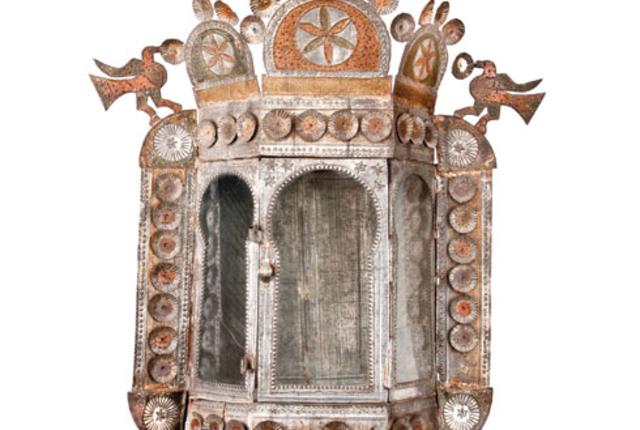Above An 1885 nicho, made of tin and glass, by Higinio Gonzales.
Photo: David Nufer/Albuquerque Museum
Gift of Dr. Ward Alan & Shirley Jolly Minge (PC1997.51.10.A)
NEED TO KNOW
December 19–April 4, 2016
The Artistic Odyssey of Higinio V. Gonzales: A Tinsmith and Poet in Territorial New Mexico, Albuquerque Museum of Art and History (505) 842-0111; albuquerquemuseum.org). Accompanying the exhibit is a comprehensive book of the same name, by Maurice Dixon (University of Oklahoma Press).
GIVEN THE OPPORTUNITY, Maurice Dixon would do away with the phrase “Valencia Red and Green Tin-smith.” For decades, art historians used it to define a style of 19th-century Hispanic religious art that they believed was created by mysteriously anonymous craftsmen clustered around Los Lunas. But after 19 years of painstaking detective work, Dixon has shattered a myth he once enabled and found the astounding backstory of one remarkable artist—an unknown legend named Higinio V. Gonzales.
In 1990, Dixon, an artist, art historian, and self-taught tinsmith, co-authored a book about the 1840–1940 heyday of tin-smithing that relied on earlier scholarship and thus perpetuated the must-have-been-a-bunch-of-tinsmiths theory. One school was tied to Valencia County, another to Rio Arriba County. Right before publication, too late for revisions, the pair got a heart-stopping clue to an artist’s identity that soon turned his art-filled Santa Fe home into a quasi research factory. Eventually, the evidence laid waste to the notion of any geographically based schools.
It helped that the Nebraska native already loved an art form long considered the poor man’s silversmithing. During the state’s Mexican era, the Santa Fe Trail brought loads of canned goods into the region. Artists recycled the containers—pounding them flat, cutting shapes, creating decorative punches, and then expertly soldering the parts into frames, chandeliers, crosses, and chests. Many of the pieces included images of saints, and the best among them bore painted details, including graphic designs reverse-applied to glass, adding to their luster.
Homes and churches throughout the territory boasted the affordable décor, but the respect was short-lived. In the mid-20th century, Santa Fe Style decorators tore out the prints of saints, replaced them with secular mirrors, and erased their cultural intent. Antique stores sold piles of the remainders for a comparative pittance. Latter-day scholars largely dismissed the form as a folk-art afterthought practiced by untold numbers of artists. To them, that explained this bounty of work that was far in excess of what a considerably smaller handful of artists could produce.
Or did it?
In The Artistic Odyssey of Higinio V. Gonzales: A Tinsmith and Poet in Territorial New Mexico, at the Albuquerque Museum of Art and History, Dixon outlines the result of his detective work: the long-delayed debut of a spectacularly productive artist who was not only a Zelig of the New Mexico frontier, but an evocative chronicler, beloved school-teacher, all-around handyman, and lovelorn ladies’ man.
“I find it difficult to believe myself, but it’s all there—it’s all in the public record,” Dixon says.
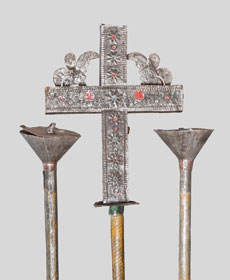
Processional cross and torches, c. 1880.
Photo by David Nufer/
Albuquerque Museum (PC1998.18.14-16)
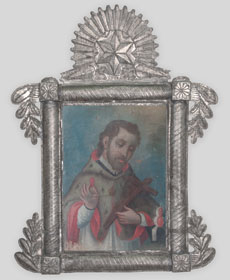
A tin-framed retablo depicting San Juan Nepomuceno, c. 1860.
Photo by David Nufer/ Albuquerque Museum (PC1997.51.18)
It began with that heart-stopping clue as Dixon and his co-author, Santa Fe gallerist Lane Coulter, finished New Mexican Tinwork, 1840–1940. While documenting artwork in mission churches, artist and author Marie Romero Cash found a tin nicho bearing a rare signature, an 1872 date, and a location—San Ildefonso, a Spanish village next to the northern New Mexico pueblo. She called Dixon and Coulter, who scrambled to learn more. They found a census reference to the signer, “H.V. Gonzales,” and managed to squeeze four pages about him into the back of the book. Heeding the San Ildefonso reference, they tied him to the Rio Arriba Painted Workshop, with this caveat:
“Until a more firm connection is established with a larger number of identifiable works ... we must hesitate in assigning any of the other named workshops from northern New Mexico to him.”
And there the matter uncomfortably lay. Dixon returned to other interests, including literary folklore. He expected other researchers would pick up the clue and find the larger story. None did, but more clues trickled in.
One of them indicated that Gonzales may have been a musician. In 1996, Dixon dug into famed folklorist John Donald Robb’s archives at the Center for Southwest Research in Albuquerque. He found copies of Gonzales’ poetry and songs and 1940s-era interviews with people who said he was their school-teacher. One of them noted that Gonzales had also worked as an editor at La Voz del Pueblo, a Las Vegas newspaper.
“At that point,” he says, “I decided that I’m getting old, no one is going to correct the book, so I have to.”
What he couldn’t do, though, was say with any authority that this or that unsigned piece of tinwork came from the master’s hand. As a working tinsmith, he knew that handmade metal punches would carry unique qualities that just might represent a fingerprint, but the nicho, made mostly of glass, was no help. Then the Millicent Rogers Museum in Taos asked him to repair a tin nicho that had broken. Based on the caliber of its drawings and the calligraphy that it bore, he suspected it was a Gonzales. He asked for paperwork on how it had come to the museum, and bang!—the smoking gun appeared. The accession record said the piece was once given to famed San Ildefonso potter Maria Martinez by the son of Higinio Valentín Gonzales, its maker.
On the damaged piece, Dixon spied two unique stamps. One looked like a deer track, the other a star with an off-kilter ray. He matched those to a second tin piece, then matched that one’s unique stamps to yet another piece. “I ended up doing something like a genealogical chart as big as my living room,” he says.
Dixon found verifiable Gonzales pieces from Socorro to Española, in styles far beyond red and green embellishments. From census, military, and newspaper records, he revealed a life remarkable even beyond Gonzales’ prolific tinsmithing.
Born in Santa Fe in 1842, young Higinio lived on East San Francisco Street, near pioneer businessman Ceran St. Vrain. The boy became friends with Archbishop Lamy’s cohort, Father Juan Felipe Ortiz, who likely included him in the first school for boys.
In 1861, Gonzales joined the Army’s First New Mexico Volunteers, which beat back the Confederate charge. After the war, he served as a courier, spurring a horse from Fort Stanton in the south to Fort Wingate in the west and Fort Union in the northeast. Whose paths did he cross? Kit Carson? Billy the Kid? Governor Lew Wallace?
“He knew the state, he saw it all happen,” Dixon says. “This is as much about the territorial history of New Mexico as Gonzales’ history.”
Dixon found songs Gonzales had composed, including the first known corrido written in New Mexico, about a dying Río Arriba County cowboy. He discovered memorias to fallen friends and hand-decorated odes from a lovesick heart. In census records, Gonzales variously listed his occupation as schoolteacher, laborer, and mason.
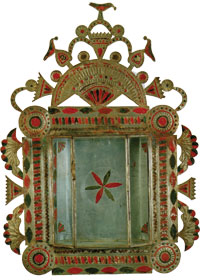
One of Gonzales’ red and green nichos, c. 1875.
Courtesy Private Collection.
And then came the tinwork.
“It’s a lovely craft, but in the hands of someone like Gonzales, it is art,” Dixon says.
Beyond employing his stamps in ways unique to each piece, Gonzales allowed stretches of unstamped tin to add elegance to his designs and brilliantly rendered faces, flowers, and birds. He possessed a painter’s hand that blended folk art sensibilities with European skill.
The Albuquerque Museum exhibit features about 200 pieces, including a large processional cross set with a bit of tin still charmingly carrying its PURE LARD logo. An elaborate nicho that bursts with tin fans, spheres, and birds, along with luscious red and green details is, to Dixon, a mark of Gonzales at his best.
“It’s all there—the monumentality, the use of multiple parts, negative space as a design element, red and green paint, and the profusion of stamped surfaces,” he says. “He’s Valencia, he’s Río Arriba, he’s everybody. That’s the problem with that first book—we identified the artists based on where the pieces were found, not their artistry.”
Dixon and the museum’s history curator, Deb Slaney, gathered pieces from a number of private collectors and institutions, including the Heard Museum, El Rancho de las Golondrinas, the Museum of International Folk Art, the Museum of Spanish Colonial Art, and the New Mexico History Museum. In addition, they’ve populated the gallery with examples of Gonzales’ music and poetry, and a hands-on station for aspiring tinsmiths.
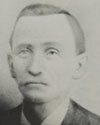
The artist, who lived from 1842 to 1921.
Photo: courtesy of the University of New Mexico. John Donald Robb Musical Trust (000-497).
For all of their efforts, mysteries remain. Who were the other tinsmiths? Did Gonzales ever live in Valencia County? (Dixon suspects he taught school there, but he hasn’t found a shred of evidence to prove it.) Are there undiscovered masterpieces, any other poems? What was his final fate?
“At the end of his life, he was nearly blind,” Dixon says. “His last teaching position was in Canjilon, about 1906. He was living with his fifth paramour, who was his third wife.”
There, the trail goes cold. Dixon can’t find an obituary of the man who wrote memorial poems for others. He has no evidence of a funeral or a grave for an artist whose works still bedeck churches.
“At one time, people knew who he was,” Slaney says. “They bought his work and recorded his poems and sang his songs, and then he was forgotten. Now he’s back.” ✜
Kate Nelson is an award-winning journalist who also works at the New Mexico History Museum/Palace of the Governors in Santa Fe.


